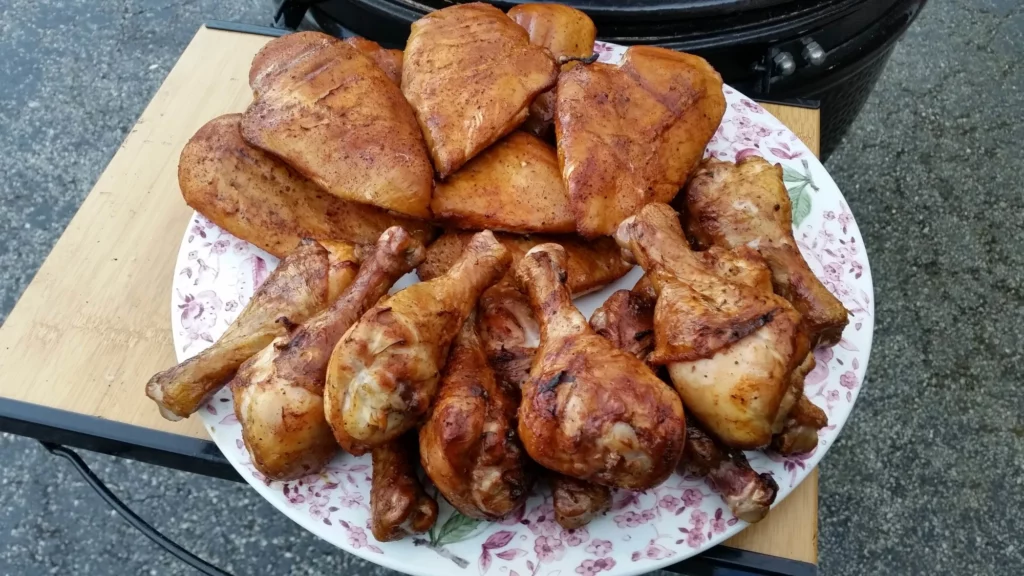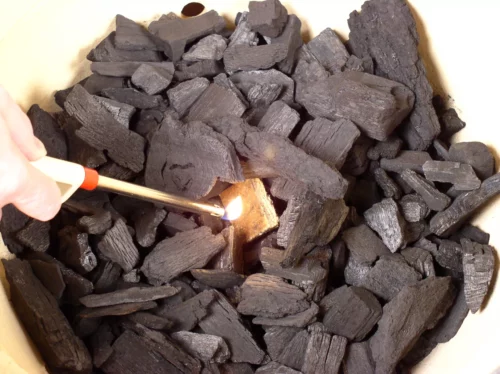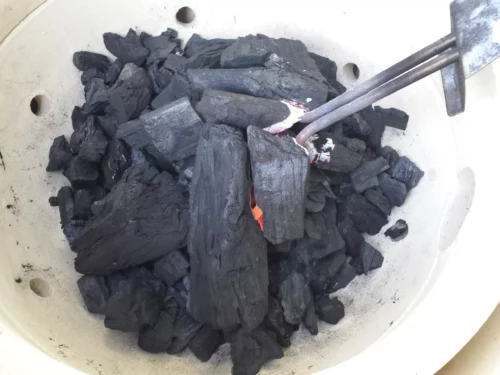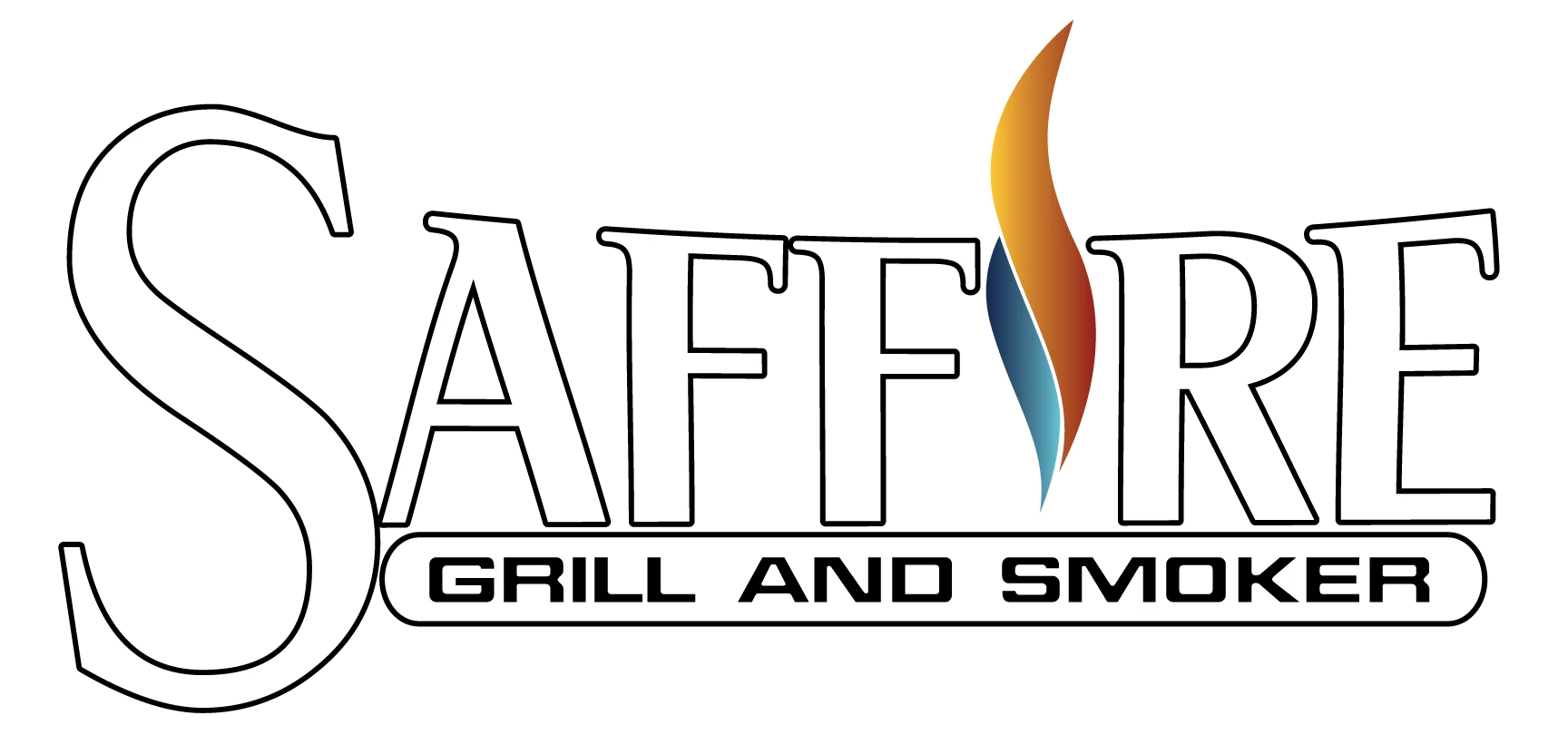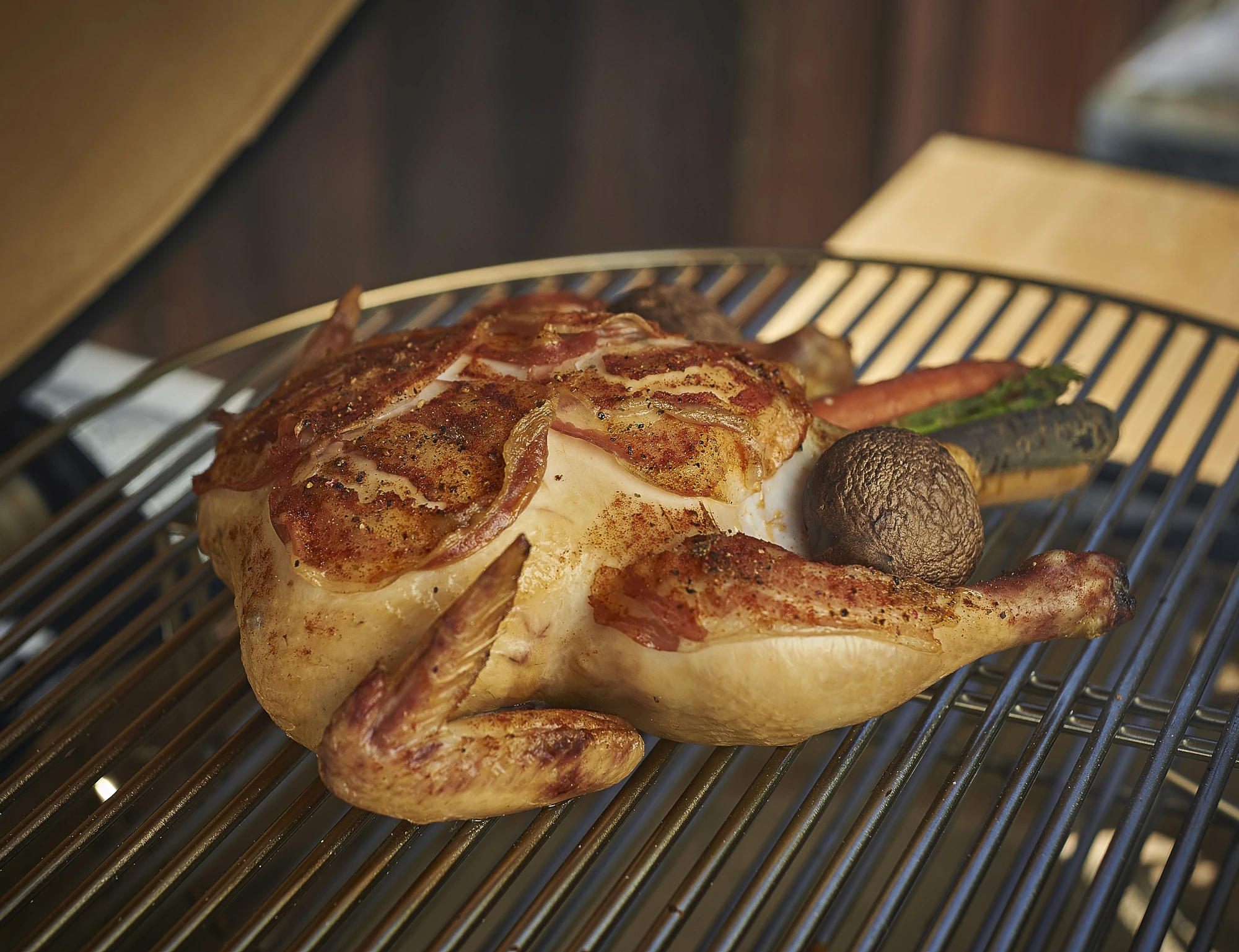
Grilling with Saffire
How to Cook Like a Champion
Kamados are well-known for cooking mouth-watering meats: steaks, ribs, burgers, poultry, and even fish. Kamado grilling not only means high-temperature grilling, but also slow smoking and even baking. With a Saffire at your disposal, you can learn how to cook almost anything on a kamado.
Imagine such exotic foods cooking on your grill as pork roast, pot pies, beef jerky, pizza/calzones, bacon and eggs, homemade bread, or clams. You can make a stir-fry on a kamado, for grilling’s sake! So load up your Saffire with all-natural lump charcoal, because you’re about to learn how to cook like a champion!
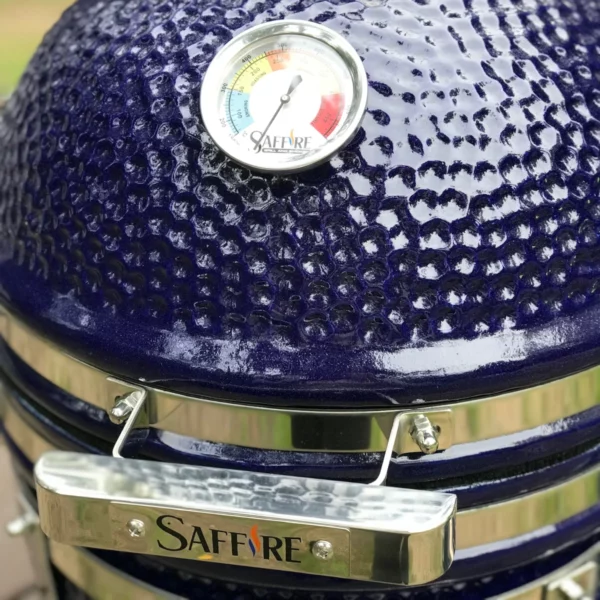
The Easiest BBQ Vegetables on a Kamado in 5 Simple Steps
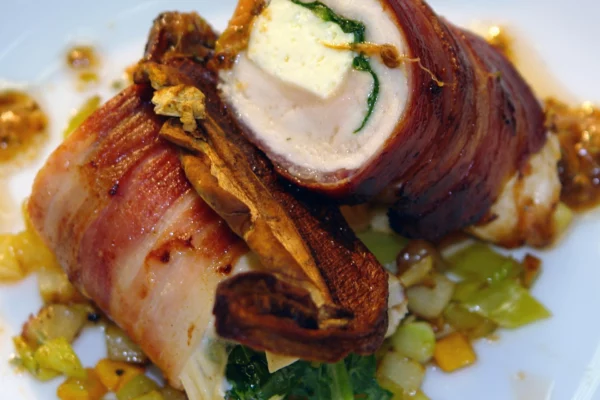
Cheesy, Bacon Wrapped Chicken with Hash Browns
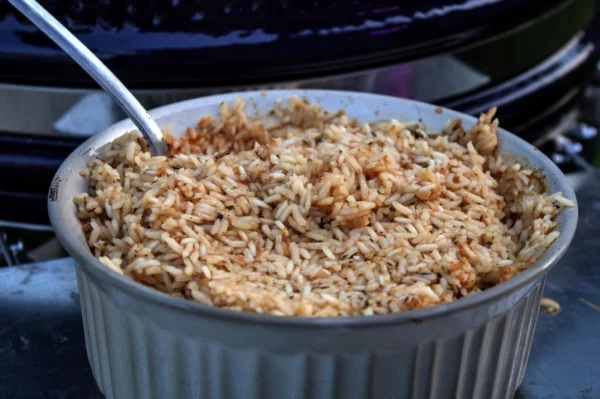
Ancient Rice Cooking Method – A Kamado Rice Recipe
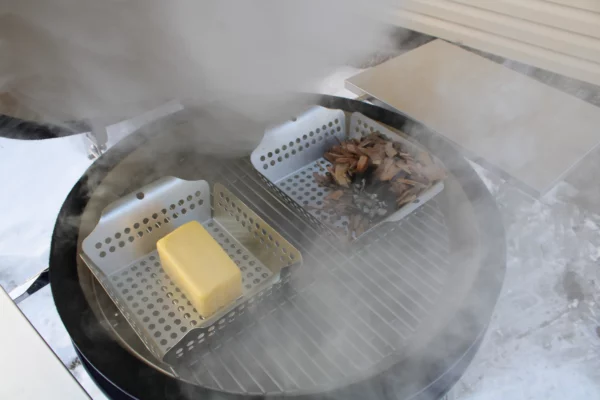
How to Smoke Cheese in a Saffire Kamado
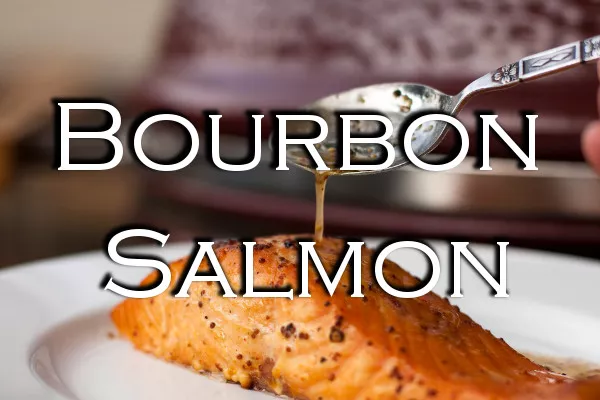
Bourbon Maple Smoked Salmon
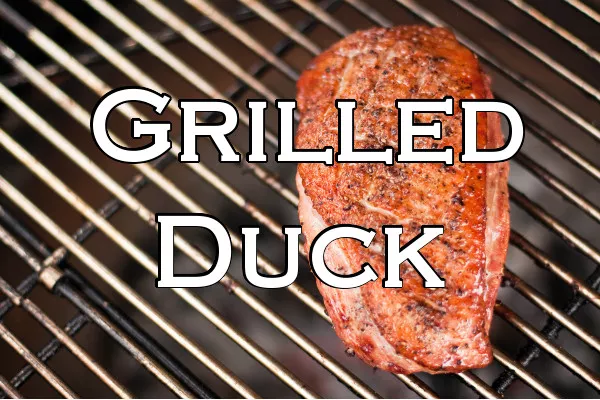
Kamado Grilled Duck Breast
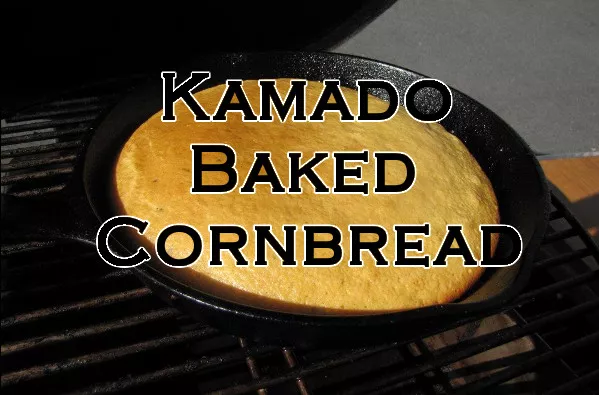
Kamado Baked Cornbread
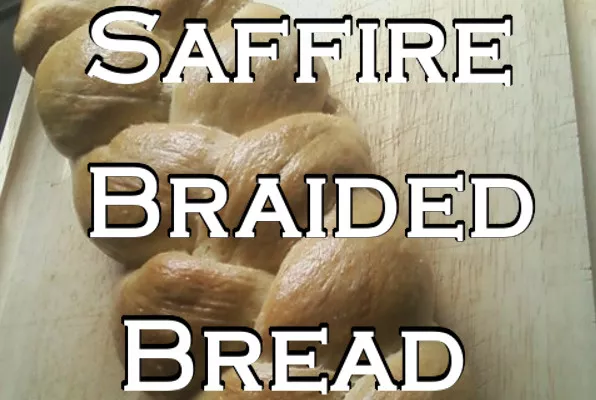
Saffire Braided Holiday Bread
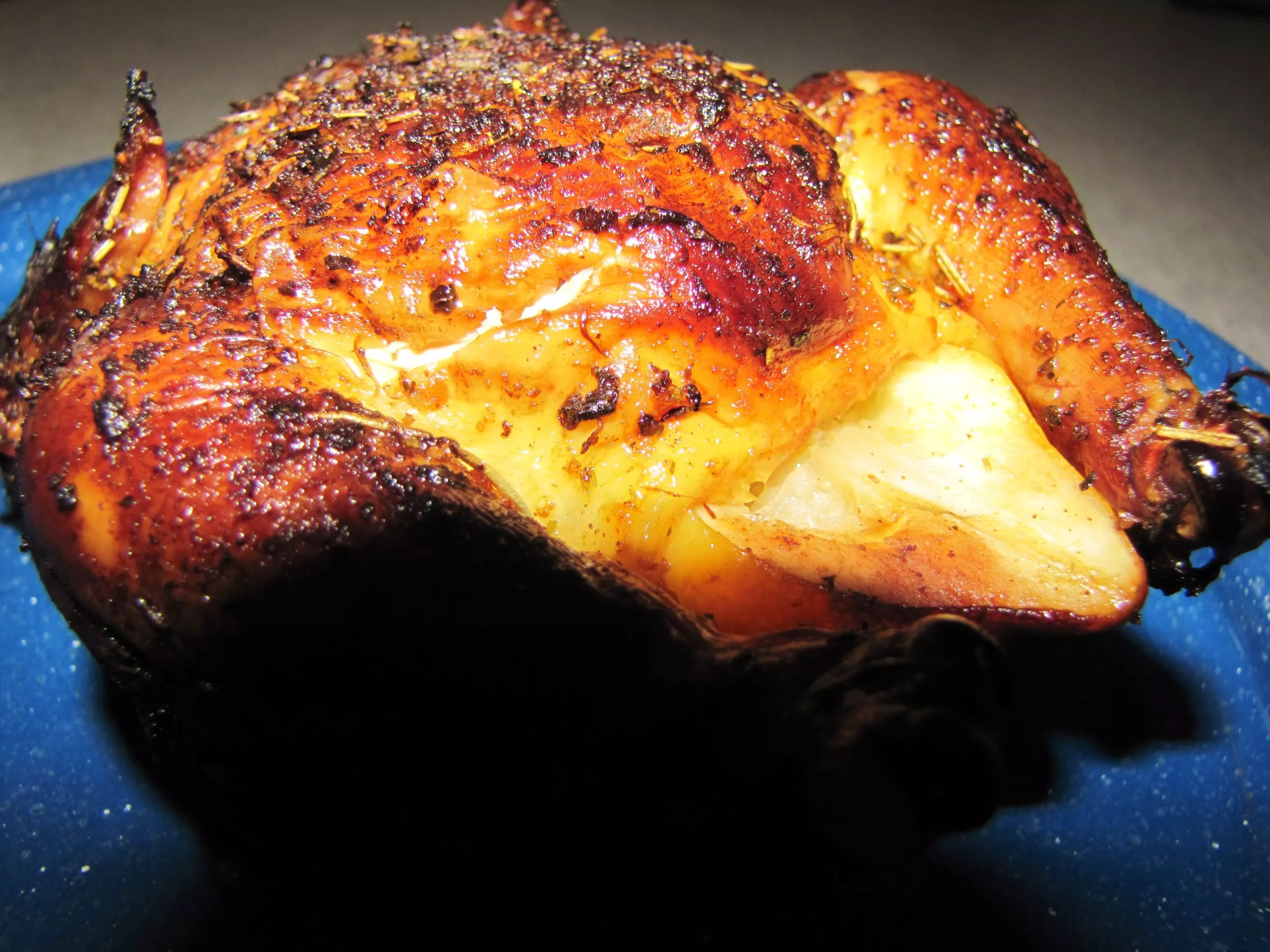
Smoked Cornish Game Hens
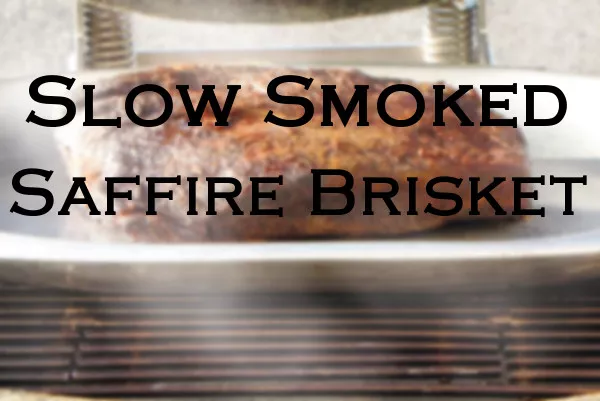
Kamado Smoked Brisket in a Ceramic Cooker
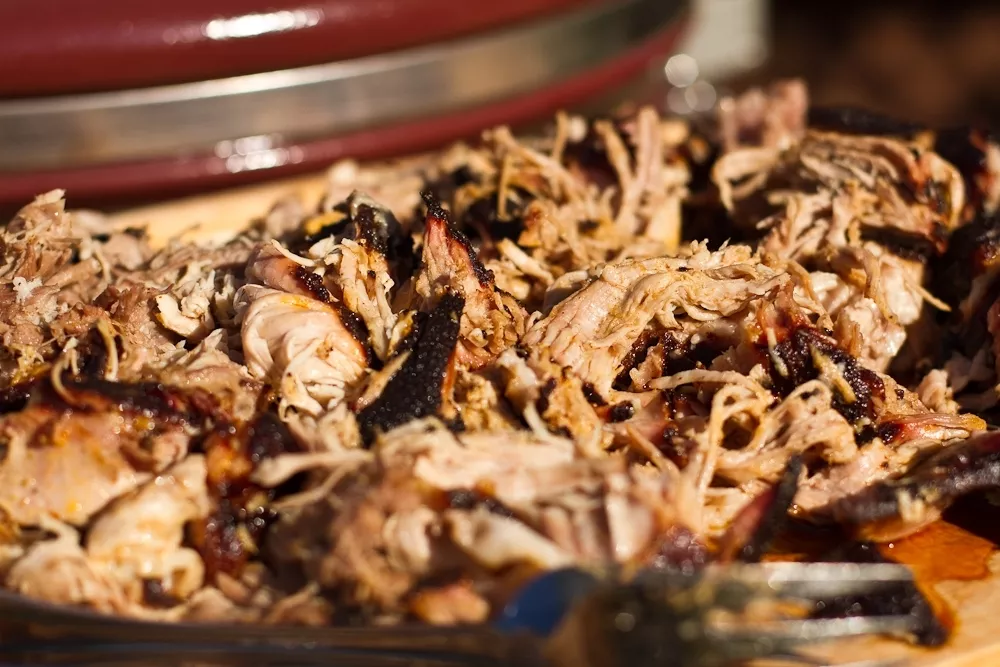
How to Use Your Saffire: Kamado Grilling
How to Start the Fire
Not only does lighter fluid have an odor and lower the quality of your food, but it can also damage the ceramics in your grill. Using it will void your warranty!
Preparing to Start the Fire
- Remove the Cooking Grid. (You can hang the grid on the Side Shelf Tool Hooks while you light the fire.)
- Remove excess ash.
- If you have a Charcoal Basket, just give the Charcoal Basket a shake to knock excess ash down into the Ash Pan. This helps maintain better air flow for easier starting. Then any remaining charcoal is good to use again.
- For grills without a Charcoal Basket, stir the charcoal around with your Ash Cleaning Tool. This will knock the ash down through the Cast Iron Fire Grate, where it can be removed through the bottom vent/ash door.
- Add charcoal as needed.
- If you have a traditional ceramic Firebox, pour lump charcoal into the Firebox, on top of the Cast Iron Fire Grate, until it covers the series of round holes in the Firebox. When you want to cook or smoke for more than three hours, you can fill it to the top of the Firebox instead.
- For grills with Saffire’s Crucible Firebox, you can fill the Charcoal Basket all the way up, or load the Crucible’s Fire Grate with three inches of charcoal. (Remember to leave a space between the charcoal and the firebox, so air can reach the charcoal on the sides for optimal heat.)
NOTE: When you want to use the “Smokin’ Chip Feeder” to add wood chips to the fire, it’s good to make sure the charcoal is not covering the access port at the front of the firebox area (see details under Smoking on a Saffire).
Starting Your Kamado
- Start the fire.
- When using a combustible fire-starter, nestle one down into the charcoal. You can place fire-starters in more than one spot in the charcoal if you want to get the whole area burning quicker for high-temperature kamado grilling and searing. (While arranging your starter, you can stack some charcoal around it to speed up the ignition process. Be sure to leave enough air space around the stacked charcoal for the air and flame or it will not burn properly.) Now light the starter.
- When using an electric fire-starter, nestle it down into the charcoal so it rests in the charcoal just above the Fire Grate. The charcoal should envelope the lower half of the starter element. At this point you can plug in the starter. Remember to unplug and remove the starter within 8 minutes to avoid damaging the starter. Once you see a nice ember going inside the charcoal, the fire should continue to increase even after removing the starter.
- Let the temperature rise. Replace the Cooking Grid and close the grill. Then swing the Chimney Top Air Control fully open until the grill is up to the desired temperature.
- Adjust the temperature the way you want it. When the grill has reached the right temperature, adjust the Top and Bottom Air Controls according to your needs (see Controlling the Temperature).
Don’t forget to extinguish the fire when you are finished cooking. Simply close the Top and Bottom Air Controls to snuff the fire out. This will efficiently preserve any remaining coals for next use. (Note that you can close the Air Controls before your food is finished cooking. Your Saffire will hold its heat for a long time. However, see the safety section below.)
How to Control the Temperature
Temperature Control Guide
Starting, and High Temperature Grilling and Searing
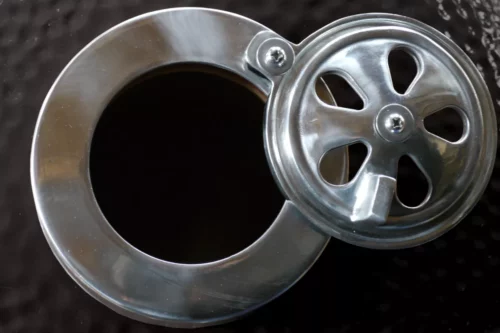
AND
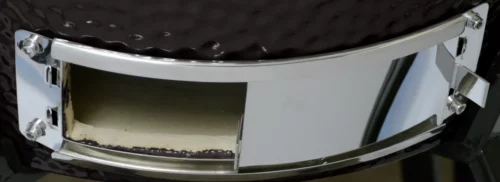
This setup will result in approximately the following temperatures:
600+°F or 300+°C

AND
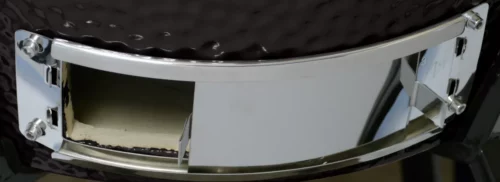
This setup will result in approximately the following temperatures:
500+°F or 260+°C
Roasting, Baking and Grilling
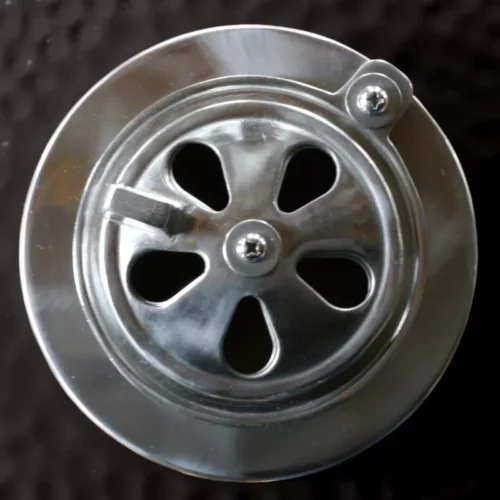
AND
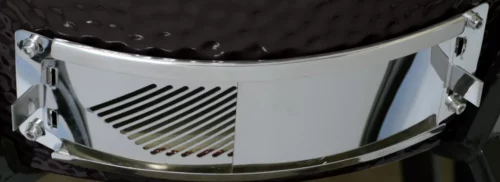
This setup will result in approximately the following temperatures:
450+°F or 230+°C

AND
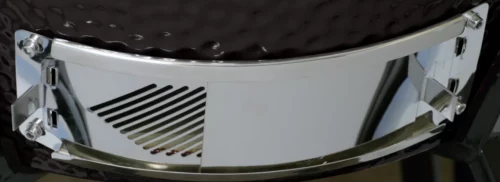
This setup will result in approximately the following temperatures:
300+°F or 150+°C
Smoking and Warming
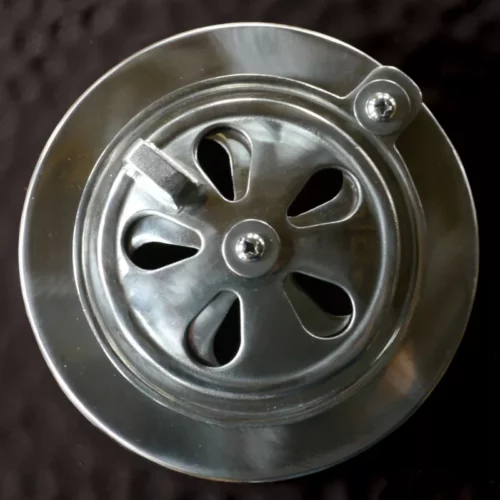
AND
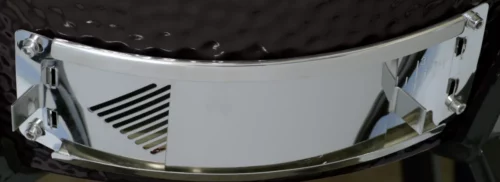
This setup will result in approximately the following temperatures:
250+°F or 120+°C

AND
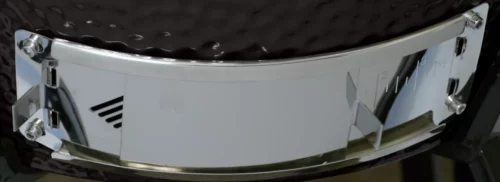
This setup will result in approximately the following temperatures:
175+°F or 80+°C
Allowing temperatures that exceed 900° F pose a safety hazard.
Avoid High Temperatures
When the thermometer at the top of the kamado is near 600° F (300° C) the temperature at the lowest cooking grid position is 1,000° F (540° C)!
When cooking, there shouldn’t be any need to exceed a temperature of 700° F. Be careful not to exceed 750° F (400° C) on your thermometer, or you risk damaging your gasket, internal ceramic firebox and/or internal ceramic fire ring. Your grill should never reach 1,000° F at the dome, as this posses a safety risk.
Note: We recommend that the top and bottom Air Controls be adjusted in sync with one another so that the bottom control is not open much more than the top control. As air reaches the fire and is superheated, it expands greatly. With this in mind, it is better to slow the fire down by first reducing the bottom damper opening, and then reducing the top damper opening. This is recommended, but is not a safety issue.
Using the Cooking Grids
When using the Multi-Level Cooking Rack, you can place half-grids at the lower level or at the top level depending on how much heat you need. You can also cook on both levels at once. If you desire to cook on the full diameter of the cooking area on both levels, you can purchase two more of the half-grids for this purpose. You may also add another level of cooking with the Secondary Cooking Grid (SCG).
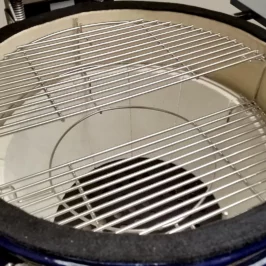
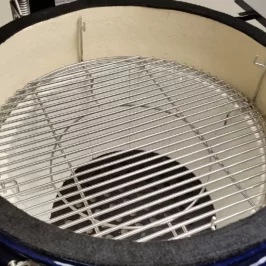
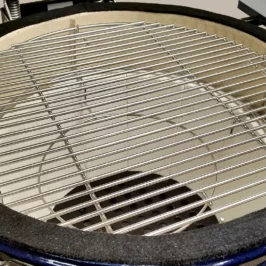
How to Roast and Smoke with the Heat Deflector
Why Use a Heat Deflector?
When Roasting or Smoking, you want to cook with indirect heat to avoid burning the surface of your meat. This can accomplished by putting your food on a rack which is placed inside a pan. After which you can add water, juice, etc. to the pan for a more effective buffer from the heat.
However, an easier way to accomplish this is to use Saffire’s Ceramic Heat Deflector. When a Heat Deflector goes underneath your food, it creates an indirect, convective heat. This is handy any time you find yourself cooking extra thick meat, which may otherwise become overly done on the outside, before the inside has finished cooking.
Heat Deflectors turn your Saffire into a highly efficient smoker and oven, where both convective and radiant heat comes back down onto your food from the dome of the grill. The result is even heat all around your masterpiece, eliminating the need for rotisseries, water pans, meat racks and all of the preparation and cleaning that goes along with them.
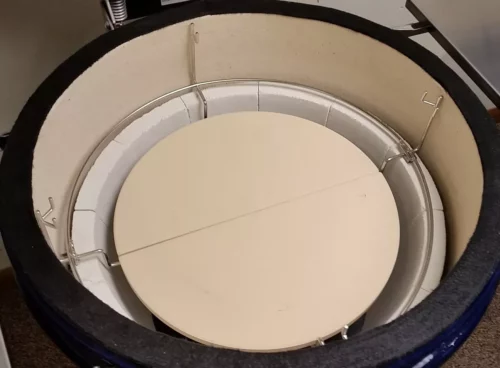
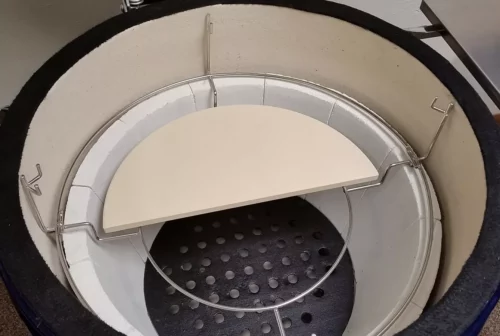
How and When to Put in the Heat Deflectors
After starting the fire, place your Ceramic Heat Deflector on the bottom of the Multi-Rack. Use just one half-deflector if you want indirect heat on one side and direct heat for grilling on the other side. A space is left between the deflector and the firebox for the heat to flow. We recommend placing a disposable aluminum pan, or foil with the edges bent up, on top of the Ceramic Heat Deflector, to catch any drippings. That will keep them from running into the fire and prevent minor flair ups.
Once the Heat Deflector(s) are in place, the Cooking Grids may be placed in the desired position on the wire rack.
The Fire/Pizza Stone and Heat Deflector, being ceramic, may retain heat for a long period of time. Use protective gloves when handling them after use, and do not place on combustible surfaces.
Smoking on a Saffire Kamado
The Chimney Top, along with other metal hardware, can get very hot. If the ceramics are warm to the touch, the metal may be very hot! As with any grill, be careful when touching any metal components on the grill while the grill is in use.
To add wood-smoked flavor to your food, you can use either wood chips or wood chunks. For wood chunks, add them to the fire before you start cooking. On the other hand, with Saffire, you can easily add wood chips to the fire at any time via Saffire’s unique Smokin’ Chip Feeder System.
With the Smokin’ Chip Feeder System you do not have to fight with the fire or even open the grill to add your wood chips. It also eliminates interrupting the cooking cycle and loosing heat from your grill. The best smoker for ease-of-use for sure! Here’s how to use the Smokin’ Chip Feeder System.
- Spread a handful of chips into the open portion of the stainless steel cylinder.
- Unscrew the round access port cover from the front of the smoker.
- Slide the open end of the cylinder with the wood chips into the smoker via the access port and twist it 180° to deposit the chips onto the coals.
- Remove the tool from the grill and replace the access port cover.
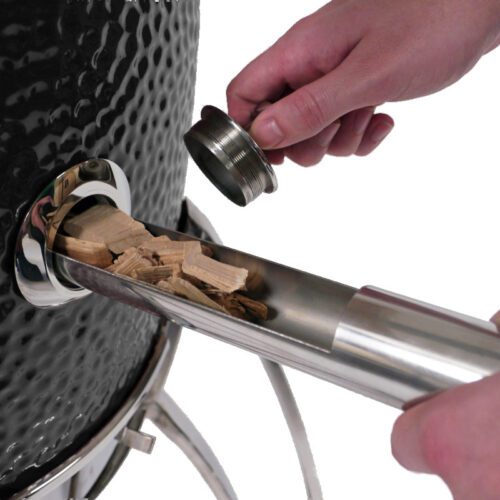
Smoke Intensity Chart
| Intensity | Chip Flavor | Meat |
|---|---|---|
| 1. | White Cedar | Salmon |
| 2. | Alder | Seafood |
| 3. | Sugar Maple | Poultry & Pork |
| 4. | Apple | |
| 5. | Cherry | |
| 6. | Beechnut | |
| 7. | Hickory | |
| 8. | Red Oak | Beef |
| 9. | Olive | |
| 10. | Mesquite |
Secondary Cooking Grid
With the Secondary Cooking Grid (SCG), which is placed on top of the full circular cooking area, you get an even larger cooking area. It is elevated 5 inches above the cooking surface below, which allows enough room to access and turn food on the lower level without removal.
To add the Secondary Cooking grid to your grill, look for the tab welded to the bottom and back of your Cooking Grids. Place the back leg of the grid on this tab. Then let the front legs rests on the bars of the Cooking Grids.
Cleaning the Cooking Grid
While it isn’t necessary to use soap to clean the Cooking Grids after every cook-out, we do suggest using a wire brush on your grids before you cook. Here’s how to do that.
After starting the fire, put the Cooking Grid into position and allow it to heat up at a high temperature setting (500° F) for 5 to 10 minutes. Then brush the grids, close the lid and slow the grill down with the Air Controls. Finally, a good way to finish cleaning and prepare the grid for food is to wipe it with a cloth soaked with vegetable or olive oil. You can use your grill brush to aid in the application. A small piece of cloth will normally stick to the wire brush quite well. Do this just before putting food on the grill.
How to Clean out the Ash
This prevents air from flowing around the grate, causing the grate to get extremely hot and reducing its life expectancy.
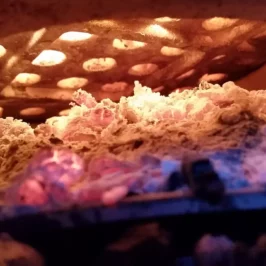
Before each cook, you should stir the charcoal with your ash tool, which helps drop any ash among the charcoal down through the charcoal grate. Then when the ash area below the charcoal grate starts getting full, make sure to rake the ash out through the air control at the bottom of the grill and into a bucket.
However, if your Saffire Grill is equipped with the Charcoal Basket and Ash Pan, cleaning is so much simpler. Just grab the basket’s handles and shake the ash down in the pan. After that, lift the basket out and set it aside. Now you can pull out the Ash Pan and dump the ash into a noncombustible container. Kamado grilling: clean and easy!
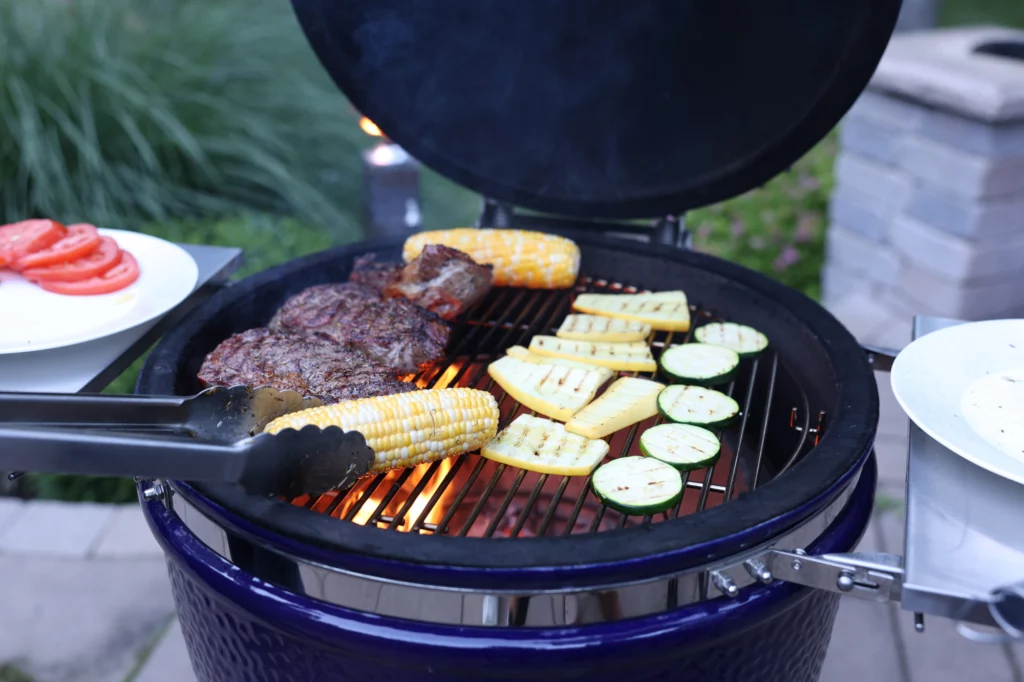
Cooking Guidelines
Pizza
General Guidelines
The Saffire makes a fantastic ceramic pizza oven! Here are three ways you can set it up:
- Place a Pizza Stone on top of the Cooking Grids, level with the top of the grill. (This may incur a little extra wear and stress on the Cooking Grids over time, especially if you are an avid pizza chef.)
- Invert the wire Multi-Rack and set the Pizza Stone on top.
- Mount the Saffire Accessory Bracket on the Multi-Rack and place the stone on top.
After adding the Pizza Stone, bring the grill up to 500°-600° F and maintain that temperature with the Air Controls set to high (see Controlling the Temperature).
Once the grill has reached 500°-600°, do not wait much more than a couple of minutes to put the pizza on. First spread a layer of corn meal on top of the Pizza Stone, and then place the pizza on that. Careful vigilance is required to ensure the pizza crust does not burn.
- When making pizza from scratch you can build your pizza right on the stone.
- Wearing gloves and using a Grid Gripper when transporting a hot Pizza Stone is highly recommended.

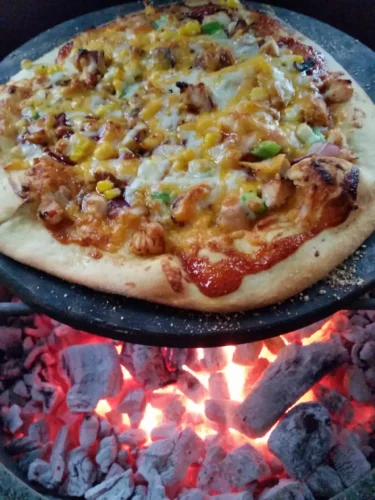
Tips for Preventing Burned Pizza
Here are some suggestions to help prevent the crust from burning. These are especially helpful when baking a thicker or stuffed pizza, calzone, etc., which has a tendency to burn on the bottom before it cooks in the middle. Doing all of these together will help more than any one individual suggestion.
- Place the pizza on a cold Pizza Stone, and then place the stone into the preheated kamado grill. The ceramic Pizza Stone absorbs more and more heat the longer it stays in the hot grill, making it more likely the bottom of your pizza will burn.
- Place the Ceramic Heat Deflector on top of the Multi-Rack, and then place the Pizza Stone on top of the deflector. This provides a higher heat deflection to absorption ratio. You may also substitute a second Pizza Stone in place of a Heat Deflector.
- To keep the Pizza Stone the pizza sits on cooler, rotate that Pizza Stone out with each new pizza you make. You would need at least two Pizza Stones to do this, as well as a Heat Deflector or Pizza Stone for the top Pizza Stone to sit on (see suggestion #2). We suggest using the Grid Gripper, with cooking gloves, to hold onto hot Pizza Stones, along with your Ash Tool to hold it steady as needed.

Warnings — Safety and Long Product Life
While Saffire’s are very durable and safe devices to use when used correctly, we want you to know what not to do with your grill for the safest experience and longest lasting grill possible. Some of these warnings are common knowledge, and some are not, so we advice you to read through them at least once.
Safety
Burning charcoal generates carbon monoxide, which can be fatal in large amounts. Don’t use your grill in your home, garage or tent. Allow your grill to fully cool down before storing inside.
As with most grills, this can cause the additional smoke in the top of the grill to ignite into a ball of flame when it is opened. When opening the grill it is always a good practice to first open the Chimney Top completely and then lift the lid open one or two inches and hold there for a count of 5. Then open the lid fully. This allows both oxygen to enter and excess smoke to exit the grill slowly and safely.
Allowing temperatures that exceed 900° F poses a safety hazard, as the grill itself could crack.
The under grill mat should be underneath the grill, and reach at least 18″ away from the front of the grill. Hot coals and embers, if fallen or shot from the grill, can slowly start fires on combustible surfaces, leading to unforeseen property damage and loss of life.
The ash in your grill may take more than two hours to fully cool. Wait several hours to clean out the ash, or wait and do so before your next cook.
Ash may still be extremely hot, even when it seems cool. Storing ash in a combustible container may lead to unintentional fires.
Saffire’s ceramics make them much safer than traditional metal grills, however there are a few hot spots you should be aware of. The Smokin’ Chip Feeder cap on the front of your grill and the Chimney Top can get very hot as the temperature on your grill rises. Be careful when touching these metal components while the grill is in use. Protective gloves may be necessary.
Danger to Equipment
Consistent cooking at temperatures that exceed 700° F may reduce the life-expectancy of your grill.
Not only does lighter fluid have an odor and lower the quality of your food, but it can also damage the ceramics in your grill.
This prevents air from flowing around the grate, causing the grate to get extremely hot and reducing its life expectancy.
Soaking ceramic components in water for extended periods of time may increase their risk of breaking, limiting their overall lifetime. (In the case of accidental soaking, allow ceramic components to air-dry for at least 24 hours before further use in the grill.)
Salt is highly corrosive to metals. Powder-coated steels are extremeley susceptible to rust when in contact with this chemical, and even 304 stainless steel can rust with long-term exposure. If your grill is on the beach front, be sure to spray your grill down once it’s cooled after each use, and then cover it.
Chlorine is highly corrosive to metals. Never keep your grill near a hot tub, where chlorine spray and fumes can eat away at the steel components, including bands, hinge and springs.
